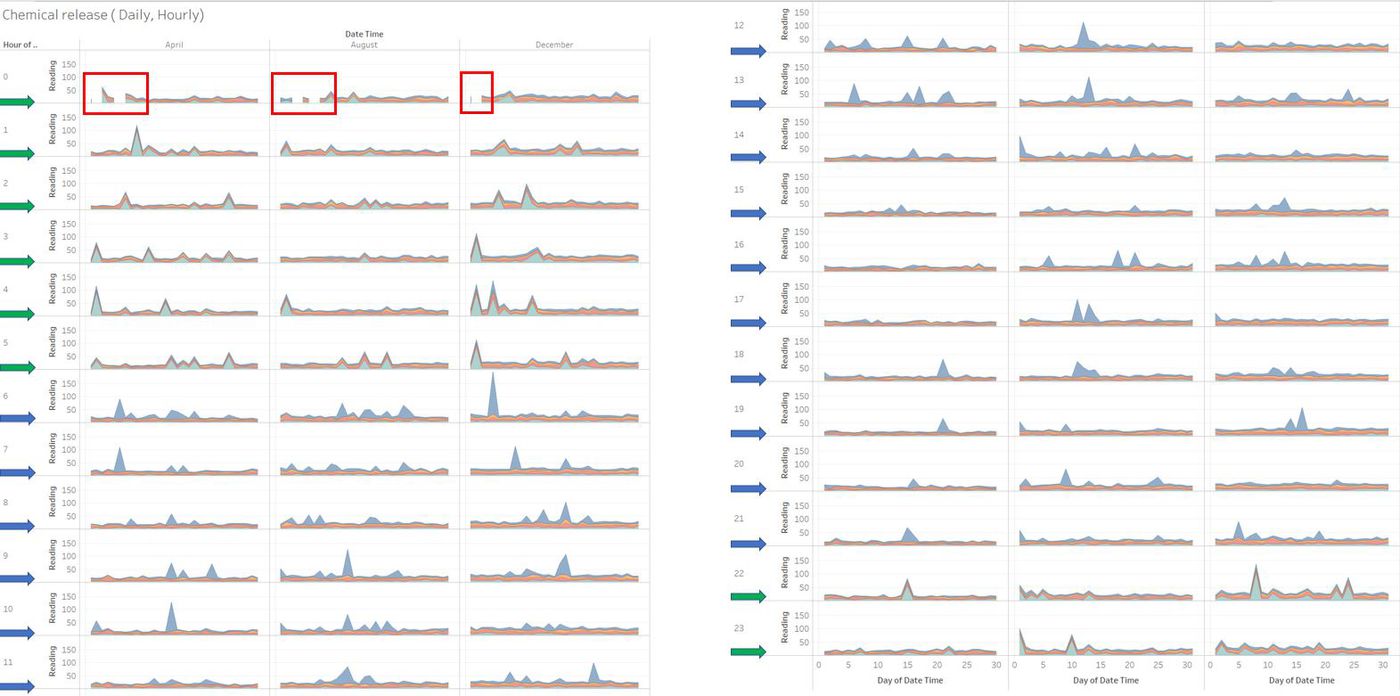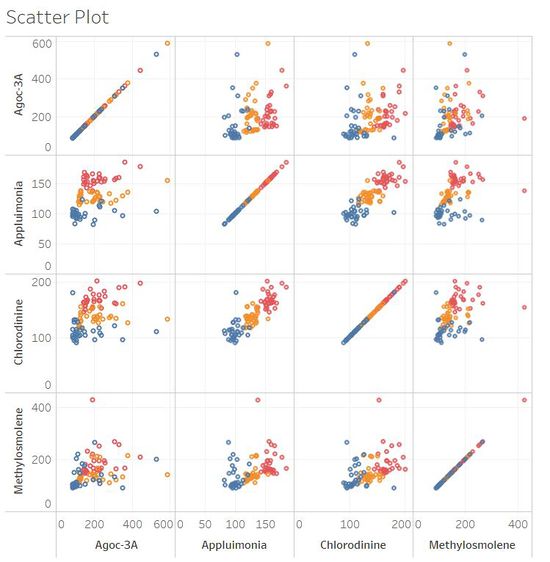Q2
|
|
|
|
|
|
|
After finding excess readings captured by the monitors of AGOG-3A chemical and less of Methylosmolene, it is imperative to see if they were released in huge quantities. If yes, then we can deduce that the high release of AGOG in large number of quantity is affecting the habitat of the nature park. To analyse the release of chemicals and their readings, a stacked graph is drawn at regular hourly interval.
The above graph is sorted on color in which Blue refers to AGOG-3A, Yellow refers to Appluimonia, Red refers to Chlorodinine and Green refers to Methylosmolene.
It is evident that there are no readings at 0th hour (12 AM) on few days of the month and this is in sync with our previous analysis on the sensor readings and its performance. The observations that can be drawn from the stacked graph is the release of chemicals at every hour. There is pattern here, every day of the three months excess of Methylosmolene is released from 10PM till 6AM and excess of AGOG-3A is released from 6AM to 9PM.
Analysis of Chemicals:
METHYLOSMOLENE:
1. Further analysis can be done on this chart to see if the release of these excess gases is consistent or not. Specially in the month of December there was excess release of Methylosmolene at around 4 AM. This could be due to several reasons such as - Factory operations, Activities in the factory abnormal from the daily routine or also the weather. Usually in many regions of the world, December is meant to be cold and the wind direction can also affect the readings.
2. Comparing all the peaks of this chemical in the above chart, it is evident that most of them occur in December than in April and August.
AGOG-3A:
1. Most of the peaks in AGOG-3A are seen during the early hours of the day when compared to evenings.
2. Wind direction and weather report will give more details to analyse and find the reason behind this excess release of AGOG- 3A.
APPLUIMONIA & CHLORODININE:
Not much information can be derived about Appluimonia and Chlorodinine from the above stacked graph. To know further about the correlation between the release of each chemical, a scatter plot is drawn for each chemical based on their daily readings.
In the scatter plot, the scatters are color sorted based on Months in which Blue refers to April, Yellow/Orange refers to August and Red refers to December.
1. There is a correlation of 0.84 between Appluimonia and Chlorodine. Thus we can deduce that as Appluimonia increases Chlorodine increases and vice versa.
2. Even though a correlation was seen in the previous question between the number of records captured of AGOG- 3A and Methylosmolene, in the scatter plot the chemicals released are dispersed and extreme values in chemical release is seen.
3. Most of the extremely scattered values are seen for August and December months.
Several questions such as Were the high values in chemicals read due to abnormal activity? What about the sensors? Were they working well? The high readings of chemicals were captured by all sensors of only certain sensors? Is it the placement of the sensor that resulted in extreme readings? Are the factory activities involved?
Further investigation needs to be performed at sensor level and for this we draw a box plot to understand the distribution and identify the presence of any outliers.
In the Box plot, looking at the daily readings we can deduce that Monitor 3 and Monitor 6 have recorded high readings. However hourly readings are necessary to understand further and it is seen that Monitor 3, Monitor 5 and Monitor 6 have recorded high values. In both the box plot majority of the points lie outside the box thus indicating that there are many values that contribute to the extreme readings captured by the sensors.
Instead considering them as outliers, construct a calendar plot to get a clear picture on the monitors and the days during which the extreme values were recorded.
Even though Box plot showed that Monitor 6 has captured extreme values of chemicals, by drilling down further with the help of a calendar heat map, it is evident that on an average compared to other monitors Monitor 3 and Monitor 4 has captured most of the high readings. Majorly December month has high readings as captured by Monitor 4. Further analysis on the weather for each day will explain the behavior of chemicals and factories.




